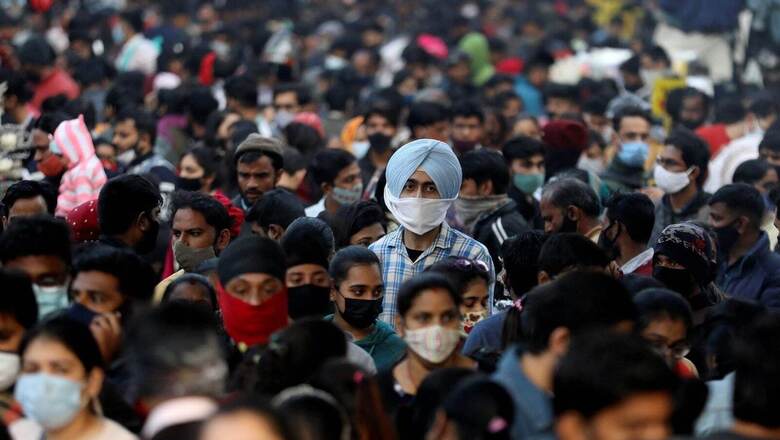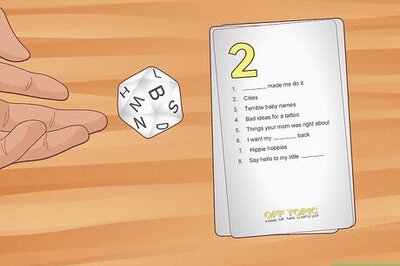
views
Amid a continuous surge in Covid-19 cases, the Delhi government on Tuesday imposed a yellow alert, a colour-coded graded response action plan, to contain the spread of the infection in the national capital. While making the announcement, Chief Minister Arvind Kejriwal said it was unfortunate that people were visiting markets and malls without masks, and appealed to them to follow Covid-appropriate behaviour.
Alarming visuals of people thronging markets neck-to-neck without following Covid-19 protocols were seen recently in Delhi. People were seen shopping in view of Christmas and New Year even amid various warnings from the central government to maintain norms to prevent a surge of coronavirus in the country. Photos and videos shared on social media platforms showed a massive footfall of shoppers at Delhi’s Sarojini Nagar Market. In one of the viral videos, men and women were seen falling on each other due to the massive crowd at a vendor’s stall and unable to move around due to it.
Experts on Monday said the number of cases will see an increase in the next couple of months in Delhi due to the Omicron variant of the coronavirus, with the peak likely to be attained in February. Dr Jugal Kishore, the head of the community medicine department at the Safdarjung hospital, said the number of coronavirus cases and the positivity rate are bound to increase, but will not translate into mortality. “What we can say is that 60 per cent to 70 per cent of the present cases could be related to Omicron, while the rest could be due to other variants. The transmission occurs because of proximity. In winter, people are indoors and meeting each other in a close-knit environment, and even the number of influenza cases rises during this period,” he said.
The colour codes were passed by the Delhi Disaster Management Authority (DDMA) in July in a meeting with Lieutenant Governor Anil Baijal, Chief Minister Arvind Kejriwal, Deputy Chief Minister Manish Sisodia, Health Minister Satyendar Jain, Niti Aayog member V K Paul, ICMR Director General Balram Bhargava, AIIMS Director Randeep Guleria, Delhi Police Commissioner Balaji Srivastava and officials of central and state governments.
The colour codes will be based on positivity rate (on two consecutive days), the cumulative number of new cases (over a week), and average oxygenated-bed occupancy (for a week) will designate four levels of alerts. According to the draft action plan, shops and establishments of essential goods and services will be allowed to open during all four levels of alerts.
Meanwhile, here’s a list of colour-coded action plan to be imposed by the Delhi government if the yellow alert which is Level 1 fails to curb the Covid-19 spread. Have a look:
YELLOW ALERT
The ‘Yellow’ (Level-1) alert will be sounded when the positivity rate crosses 0.5 per cent or new cases increase to 1,500 or oxygenated bed occupancy reaches 500. The corresponding response will involve allowing construction, manufacturing activities and the opening of shops and establishments of essential goods. However, shops and establishments of non-essential goods and services, and malls will open based on odd-even formula, from 10 AM to 8 PM.
Only one weekly market per zone with 50 per cent vendors will be allowed to open, the draft plan stated.
Amber ALERT
The next level of alert coded with ‘Amber’ colour (L-2) will come into force if the positivity rate rises above one per cent or new cases number 3,500 or oxygenated bed occupancy reaching 700. ‘Amber’ alert will invoke the same responses as ‘Yellow’ one except that malls and shops of non-essential goods and services will be allowed to open from 10 AM to 6 PM.
ORANGE ALERT
The ‘Orange’ or L-3 alert will be the next stage which will kick-in if the positivity rate crosses two per cent or new cases number 9,000 or oxygenated bed occupancy becomes 1,000. Construction activities will be allowed with onsite labourers while industrial activities will be restricted except those related with essential commodities and defense production. Malls and weekly markets will be closed. Only standalone non-essential shops will open from 10 AM to 6 PM, the draft plan stated.
RED ALERT
The ‘Red’ alert (L-4) will be the highest level and will come into force if the positivity rate crosses five per cent or new cases rise to 16,000 or oxygenated bed occupancy reaches 3,000.
Construction activities with onsite labourers and industrial manufacturing of essential commodities, national security and defence-related productions will be allowed, while malls and weekly markets will be closed and standalone non-essential shops open, they said. In May, the Delhi government had formed an eight-member state level expert committee to devise a strategy to mitigate and manage the possible third wave of Covid-19 in Delhi.
Marriages, Funerals Allowed in Limited Number
Marriages and funerals will be permitted in Delhi with a limited number of attendees across all the four grades under the colour-coded action plan. According to the proposed action plan, marriage and funeral functions will continue during all the four levels of action, with crowd size ranging from 20 (yellow and amber) to 15 (orange and red) for both the social activities. Religious places will open but with no visitors across the four graders of the action plan.
Other gatherings and congregations of social, religious, political nature, entertainment-related events and festival gatherings will not be permitted in any of the four categories of the plan that may come into force in future. Schools, colleges, libraries, educational training and coaching institutions will also be closed if the plan comes into force, in any of the colour-coded category, the proposed plan said, adding, business-to-business exhibitions will not be permitted across the four categories of action plan. Public parks, gardens, and golf courses will operate under the ‘Yellow’ category but will be closed in the remaining there ones.
Sports complexes, stadia and swimming pool facilities will closed, except for national or international sporting events, across all four categories — yellow, amber, orange and red, the plan says.
Delhi had witnessed a devastating second wave of Covid-19 in April and May this year, which saw record infections and fatalities, amid burdened healthcare facilities and a shortage of medical oxygen.
(with inputs from PTI)
Read all the Latest India News here




















Comments
0 comment